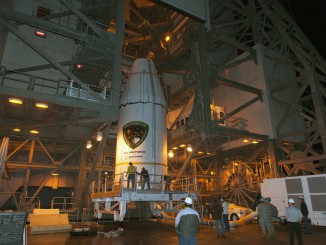
A United Launch Alliance Atlas 5 rocket made its third trip to a Cape Canaveral launch pad Thursday, rolling into position for liftoff Friday afternoon with a classified payload for the U.S. government’s spy satellite agency.
The 206-foot-tall (63-meter) rocket made the 1,800-foot (550-meter) trip from ULA’s Vertical Integration Facility to Cape Canaveral’s Complex 41 launch pad Thursday afternoon. The Atlas 5 rode a mobile platform moved along rails by locomotives.
Once the rocket was on pad 41, automatic couplers connected the Atlas 5 to ground systems. ULA’s team planned to complete inspections, checkouts, and other activities ahead of the start of the countdown Friday.
Liquid oxygen will be loaded in the first stage during the countdown Friday afternoon, along with liquid hydrogen and liquid oxygen for the Atlas 5’s Centaur upper stage. RP-1 fuel for the first stage was loaded last month during a countdown dress rehearsal.
A forecast issued by the U.S. Space Force’s 45th Weather Squadron Thursday morning indicates an 90% chance of favorable weather conditions for launch at 5:13 p.m. EST (2213 GMT). The primary weather concern is with cumulus clouds at Cape Canaveral.
Forecasters predict northerly surface winds of around 10 to 15 knots at launch time, with a few clouds at 3,000 feet. The temperature at launch time should be around 76 degrees Fahrenheit.
The Atlas 5’s mission — known as NROL-101 — will launch a classified payload for the National Reconnaissance Office, which owns the U.S. government’s fleet of intelligence-gathering surveillance satellites. The launch Friday will mark the 86th flight of an Atlas 5 rocket since 2002, and the fifth Atlas 5 mission this year. It will be ULA’s 30th mission for the NRO.
The NRO has not revealed information about the payload flying on the NROL-101 mission, but warning notices released to pilots and mariners suggest the Atlas 5 rocket will head on a northeasterly track from Cape Canaveral, following a path parallel to the U.S. East Coast before flying near the Canadian maritime provinces.
The trajectory indicates the Atlas 5 will release the NRO payload into a high-inclination orbit.
The NRO owns data relay satellites and several spacecraft designed to intercept communications signals in elliptical Molniya-type orbits that stretch nearly 25,000 miles (40,000 kilometers) above Earth at their highest points. Those orbits are tilted around 63 degrees to the equator, giving satellites regular views of Russia and other parts of the northern hemisphere.
The Atlas 5 scheduled for launch Friday might be aiming for a similar Molniya-type orbit, according to multiple independent experts who track spy satellite activity.
The launch vehicle for the NROL-101 mission will fly in the Atlas 5’s “531” configuration with three solid rocket boosters and a 5.4-meter-diameter (17.7-foot) payload fairing.
The payload fairing for the NROL-101 mission will fly in its medium-length variant, offering more volume for the classified spacecraft on-board than the standard shorter-length 5.4-meter-diameter shroud. The medium-length 5.4-meter fairing has flown on seven prior Atlas 5 missions.
The launch Friday will be the fourth time an Atlas 5 rocket has flown in the 531 variant, but it will be the first to launch with new GEM 63 strap-on boosters produced by Northrop Grumman. They are the same form, fit and function as the AJ-60A solid rocket boosters made by Aerojet Rocketdyne that have flown on all prior Atlas 5 missions that required strap-on motors.
ULA originally transferred the Atlas 5 rocket to pad 41 for the NROL-101 mission Nov. 2, but teams returned the rocket to the VIF later the same day to replace an environmental control system duct feeding conditioned air to the payload on top of the launch vehicle.
The Atlas 5 returned to the launch pad Nov. 3 for a launch attempt Nov. 4, which ULA scrubbed due to a problem with valves in the liquid oxygen ground system at pad 41.
ULA then moved the Atlas 5 back into the VIF to take shelter from Tropical Storm Eta, which moved off the coast of northeast Florida Thursday and headed into the Atlantic Ocean, clearing the way for the rocket to return to pad 41 again in preparation for Friday’s launch opportunity.
Email the author.
Follow Stephen Clark on Twitter: @StephenClark1.



